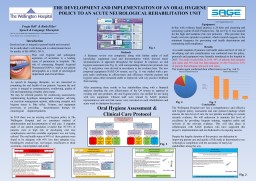

Clinical Care Protocol Freyja Bell 1 amp Ruth Elder 2 Speech amp Language Therapists Good oral care is integral to general health and essential for an individuals wellbeing and is a determinant factor for quality of life WHO 2011 ID: 1042763
Download Presentation The PPT/PDF document "Oral Hygiene Assessment &" is the property of its rightful owner. Permission is granted to download and print the materials on this web site for personal, non-commercial use only, and to display it on your personal computer provided you do not modify the materials and that you retain all copyright notices contained in the materials. By downloading content from our website, you accept the terms of this agreement.
1. Oral Hygiene Assessment & Clinical Care ProtocolFreyja Bell1 & Ruth Elder2Speech & Language Therapists Good oral care is integral to general health and essential for an individual’s well-being and is a determinant factor for quality of life (WHO, 2011).Poor oral hygiene and subsequent aspiration of secretions is a leading cause of pneumonia in hospitals. The risk of contracting Hospital Acquired Pneumonia (HAP) is high in our patient demographic as a result of neurological impairment and critical illness. THE DEVELOPMENT AND IMPLEMENTAITON OF AN ORAL HYGIENE POLICY TO AN ACUTE NEUROLOGICAL REHABILITATION UNITAs speech & language therapists, we are interested in promoting the oral health of our patients because the oral cavity is integral to communication, swallowing, quality of life and maintaining a healthy chest status.We may be referred patients for swallowing assessments; implementing dysphagia management strategies; advising on secretion management options; addressing complex oral hygiene issues ie. Bite reflex, Trismus, and equipment provision; or providing desensitisation therapy for neurological impaired patients.In 2010 there was no existing oral hygiene policy in The Wellington Hospital and no consistent method of administration and documentation of oral care. A snapshot audit of our patient population revealed that 50-70% of patients were at high risk of developing oral care complications and that available equipment was not being utilised. The oral health status of 40% of these patients were found to be adequate with 60% less than adequate (e.g. bleeding/dry cracked lips, red tongue, insufficient or thick secretions, coated palates and teeth). Fig. 2Fig. 3.1F.Bell, BSc (Hons) Language and Communication Science. freyja.bell@hcahealthcare.co.uk2R.Elder, BSpPath (Hons). ruth.elder@hcahealthcare.co.ukwww.sageproducts.comMethods A literature review was completed, along with further audits of staff knowledge, equipment used and documentation which showed major inconsistencies in approach throughout the hospital. In response, an oral hygiene assessment (see Fig. 2), with corresponding clinical care protocols (see Fig. 3) and policy were devised in accordance to the evidence base. The new proposed equipment (SAGE Q4 system, see Fig. 1) was trialled with a pre- post audit confirming its effectiveness and efficiency whereby patients oral hygiene status either remained stable or improved, with very positive feedback from nursing. After presenting these results to key stakeholders along with a financial analysis detailing the cost effectiveness of the Q4 system as opposed to existing oral care products, the oral hygiene policy was ratified for use along with new equipment. Clinical staff were trained by SAGE products representatives and oral link nurses were recruited on each rehabilitation and acute ward to champion the project. IntroductionResultsA re-audit snapshot of patients oral health status and level of risk of developing oral care complications was conducted once the policy, protocols and equipment were formally introduced to the hospital in 2015. The audit revealed that in 2010, 40% of patients had adequate oral status and 56% had less than adequate. In 2015 however, 83% of patients had adequate and good oral status.The results again confirmed their effectiveness (see Fig. 4 & 5).Fig. 1Equipment In-line with evidence based practice, a 24 hour oral cleansing and suctioning system (SAGE Products Inc., Q4 see Fig 1) was sourced for the high and moderate risk care protocols . This provides four hourly oral care episodes to patients, which research suggests is the minimum frequency for preventing oral health deterioration and maintaining staff compliance. ConclusionsThe Wellington Hospital now has a comprehensive and effective oral hygiene policy, assessment and care protocol package which ensures the best level of care for our patients according to current research evidence. We will endeavour to maintain this level of excellence by providing frequent training, snapshot audits and revision of the relevant evidence. This will take place in collaboration with SAGE products who have supported this project’s implementation and are dedicated to its ongoing success.Despite the lengthy duration of this project, our dedication to improving patient care and quality of life made us determined to see it through to completion with the assistance of many key stakeholders along the way. Fig. 4Fig. 5